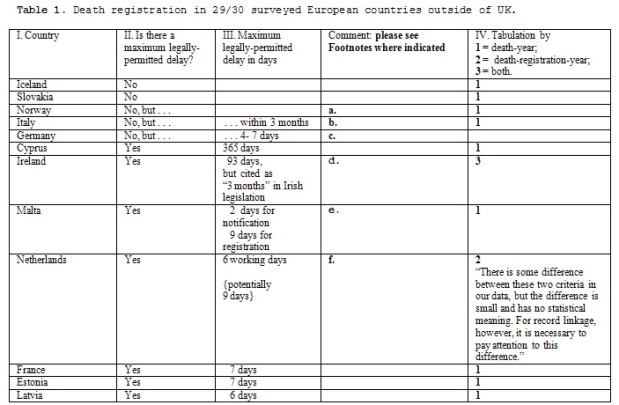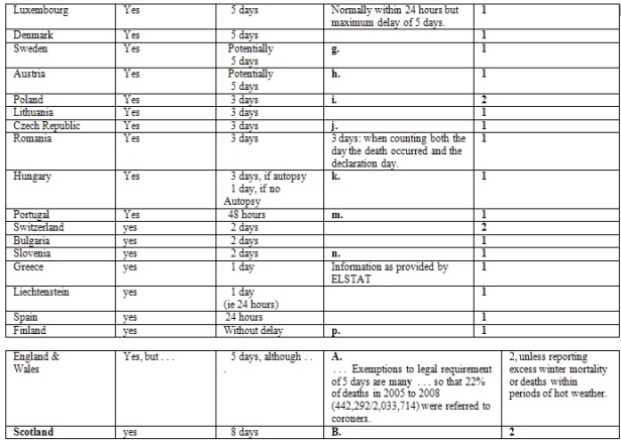Registration of deaths in European countries: survey results
In January 2012, the Royal Statistical Society issued a statement of concern about the late registration of deaths in England and Wales.
In early April 2012, I wrote to the heads of official statistics in European countries to inquire, as follows, about death-registration in their country and whether official statistics on deaths were reported by year-of-death or by registration-year.
- Which country do you answer for? Country = . . . . . . . . . . . . . . . . . . . .
- In your country, is there a maximum legally-permitted delay between the date when death was ascertained (which, typically, is the date of death) and the registration-date for that death? 1= no, 2 = YES
- IF YES in answer to ii), please specify, in days, the maximum legally-permitted delay in your country: . . . . . . . . . . . . . . . . . . . days
- In your country’s official statistical tabulations of deaths by year and cause, do you classify death by death-year or by death-registration-year? 1 = death-year, 2 = death-registration-year, 3 = both but in alternative tables
In light of the Royal Statistical Society’s interest, and as befits heads of official statistics, the response rate was impressive: 29 out of 30. Twenty-three countries, like Scotland, do not tolerate registration delays beyond 9 days. Six do, however, and – as in England and Wales – may wish to consider legislative change.
In order of maximum legally-permitted delay between date when death was ascertained and registration-date, Table 1 details the replies I received from 29/30 surveyed non-UK European countries. Colleagues were kind enough to provide explanatory detail or references to their own legislation, and I have conveyed this detail in Footnotes because it is likely to be of interest internationally.
Five countries answered that there was no legally-permitted maximum but two (Italy and Germany) qualified their answer in a manner to suggest that deaths would, in effect, be registered within 3 months (Italy) or 7 days (Germany). By contrast, two other countries (Cyprus and Ireland) which abide by a legal maximum indicated that the permitted registration delay was extensive: 365 days (Cyprus) or 3 months (Ireland). In effect, 6/29 non-UK countries have either no legal maximum or tolerate registration delays of 3 months or longer.
The maximum legally-permitted delay is otherwise 9 days or less for 23 out of 29 non-UK responder-countries. Accompanying commentary indicates that some countries take weekends and public holidays into account and so express the maximum permitted delay in terms of ‘working days’. Legislation in some countries is specific about whether the day of death is to be counted as day 1. In others, the solution is to express the permitted delay rather precisely: in hours since time of death.
Somewhat surprisingly, countries which do not impose a maximum delay on time to registration of deaths nonetheless report mortality statistics by death-year which means, in effect, that tables cannot be compiled until the latest death-registration has occurred; or need to be updated to take account of delayed-registrations.
For the Netherlands, Poland and Switzerland, as for Scotland, mortality statistics are reported by registration-year but in those four countries, unlike in England and Wales, the difference between death-year and registration-year is small. As noted by the Netherlands, this difference still needs to be paid heed to in record-linkage studies which seek to establish who is alive still by a specific date.
England and Wales, and 6 out of the 29 other European countries, fail to ensure that, without exception, all deaths are registered within 3 months. Twenty-four other nations (including Scotland) ensure that death-registration occurs within 9 days of date of death. Information on cause of death may, of course, be outstanding at the time of death-registration.
For record-linkage studies, the without-exception-maximum delay until deaths are registered matters quintessentially. The information in Table 1 is therefore crucial for public health and other scientists who wish to establish the survival-status of patients or research-participants by, or on, a specific date.


Footnotes to Table 1
a. Norway There is not a maximum legally-permitted delay between the date of death and the registration-date of death, just a demand that the death shall be reported as fast as possible through the death certificate.
b. Italy Original death certificate forms have to be sent to Istat (National Institute of Statistics) within 3 months. There is no time limit for the registration; however the EU Implementing regulation n. 328-2011 indicates that Member States shall provide the data within 24 months after the end of the reference year.
c. Germany BUT: In every legal basis of the Federal States you will find the wording “immediately after the death occurred”. That means that the certificate has to be sent on the same day the death happened. The following exceptions are sometimes noted: 1. Weekends, 2. nights, 3. public holiday.
d. Ireland The legislation in relation to registering a death states that there is a duty to register a death within 3 months. While every effort must be made to do this, it is still possible to register a death after this time.
e. Malta Registration generally takes place some time after notification (generally within a week). Still, in some cases (e.g. persons who die abroad) registration may take a longer time to happen; however these cases are generally captured in time for statistical analysis as every single notification is marked by the deceased's ID card which is also available for the statisticians.
f.Netherlands In principle, the certification of the cause of death should be also available within this period, but it is allowed to state an “unknown cause”. If the cause of death becomes known during the same year+plus+three+months, the improved information is used for statistics. Then the statistical databases are finalized. If the cause of death becomes known later, the improved information is ignored. There is no coroner-inquest-verdict system in The Netherlands, but of course police and justice do look at “suspicious deaths”. This does not delay the notification of death. The cause of death of those cases is available in the vast majority of cases before closure of our statistical data files.
g.Sweden “as soon as possible” according to the legislation, generally interpreted as the same or at latest the next working day.
h. Austria death has to be certified within the working-day following the day of the death.
i. Poland Maximum permitted registration-delay is 24 hours if death was a result of infectious diseases.
j. Czech Republic A new modified system of collection of the data on deceased persons will run from 01/01/2013. After this, the registration of “fact of the death” and the system of causes of death data collection will be divided. The civil Register offices will not get information about causes of death and the maximum permitted delay for the registration of the ”fact of death” will remain the same (3 days). The part of DC with causes of death will be sent with maximum delay of 30 days to the Institute of Health Information and Statistics (organization under the Ministry of Health).
This institute will provide the information on causes of death to the Czech Statistical Office (NSI). NSI will link it with the statistical reports on death sent from Registry offices and select an underlying cause of death.
k. Hungary Time between the date when death was ascertained and the registration-date for that death depends on the method of the examination of death. If autopsy is not necessary, then maximum one day delay is permitted. In case of autopsy, maximum 3 days delay is acceptable. Certificate on the examination of the deceased must be sent to the registrar on the first working day after the ascertainment of death at the latest.
In Hungary, data collection for death statistics is processed together with registration. Death record is the second copy of the record used for registration, which contains demographic data of the deceased person. The certificate on the examination of the deceased contains information on causes of death, which is the first-master item of the document necessary for registration and burial.
m. Portugal To be counted on the basis of the a) time of death, b) time when the body was found or autopsied, c) time when autopsy was exempted, d) time when a copy of the burial note issued by the police authority was received.
n. Slovenia The legal basis for civil registration of death is Article 13 of the Register of Deaths, Births and Marriages Act (OJ RS, No 11/2011). Medical registration of death (with causes of death) is done at the latest within 3 months after the civil registration of death. There is no legally basis, only gentlemen`s agreement between institutions. Statistical tabulations are made at the latest 7 months after the reference period. The legal basis is the Annual Programme of Statistical Surveys for 2011 (OJ RS, No 92/11).
P.Finland Registration without delay (by law), and death certificate must be sent within 3 months to the supervisory state body, i.e. in about 91-92 days.
A. England & Wales: Deaths should be registered within 5 days of the date of death, although there are a number of situations when the registration of death will be delayed – this is when a death is reported to the coroner and the registration is consequently delayed.
Deaths should be referred to the coroner include those where: Cause is unknown; Deceased was not seen by the certifying doctor after death or within 14 days before death; Death was violent unnatural or suspicious; Death may have been due to: an accident, self neglect, suicide, an industrial disease, or related to the deceased employment; Death occurred: during an operation; during or shortly after detention in police or prison custody, or there was no doctor available who was legally qualified to certify the death.
B. Scotland:
Please see 2nd paragraph on this page: http://www.gro-scotland.gov.uk/regscot/registering-a-death.html .However, a small proportion of deaths are registered more than 8 days after the death (2% in 2006 - and I doubt that it has changed much since then) - please see Chart 2, at the foot of this page http://www.gro-scotland.gov.uk/statistics/theme/vital-events/general/weekly-monthly-births-death-data/weekly/index.html. If the actual cause of the death is not known, it may be registered with something along the lines of "unascertained awaiting investigations" or "unascertained pending toxicology" shown as the "cause" (which will later be replaced by the "proper" cause of death, once that has been established).



